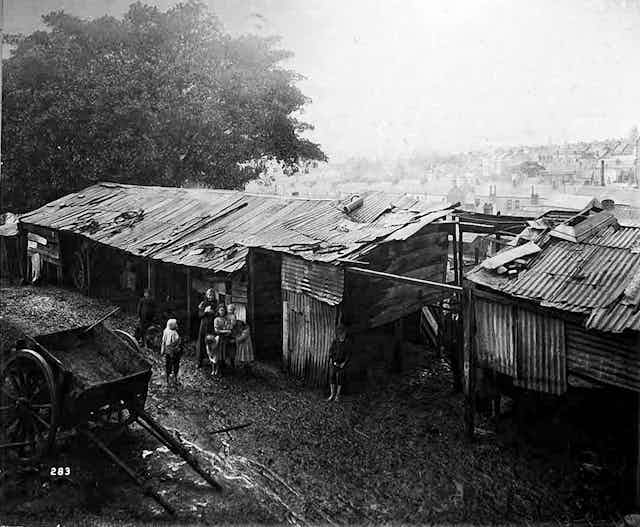Truth be told, most Australians live in good housing. This is good news for all of us because our housing is a major determinant of our health and wellbeing. But our very recent research findings, published this month in the Journal of Prevention and Intervention in the Community, and the lessons of history tell us this good news story is at risk.
Ideally, housing provides us with the secure, comfortable shelter that people and their families need to live healthy, productive lives. In general, we have a modern housing stock with good heating and cooling, few major structural problems and few problems with damp and mould. By contrast, bad housing makes it much more likely you will get sick and stay sick once ill.
In Australia’s early years, much of the housing stock was of poor quality, often overcrowded, and posed real risks to people’s health. Slums were common in the inner parts of the major cities and in many country towns.
As late as 1915 bubonic plague was a reality in the poorer parts of our cities and other contagious diseases remained an ever-present risk. Numerous letters to the editor documented a real social concern with the housing standards of the poor.
Government intervention, economic prosperity and tenancy laws all improved housing conditions across Australia. Within a century Australia was defined by good housing and high rates of home ownership. The nation saw off the last of its slums in the late 1940s.
Now the same conditions that gave rise to substandard housing in the 19th century are returning in the 21st, with a likely similar outcome. Recently, the Reserve Bank governor acknowledged young Australians need their parents’ help to buy a home in Sydney. But most Australians don’t have a wealthy and doting parent to fund them into the house of their dreams.
The alternative is to live in lower-quality housing and to make do with a home that is relatively inaccessible, fundamentally unaffordable or both.
A million Australians on the housing brink
The confronting reality is that poor housing conditions are more prevalent in Australia than we think.
We have a sizeable “hidden fraction” of Australians living in poor-quality housing. In particular, many of our most vulnerable have the double disadvantage of also having housing conditions that we might deem as falling below an unacceptable standard.
In one of the few contemporary analyses of this issue, we used the Household Income and Labour Dynamics (HILDA) Survey, a national longitudinal dataset, and find compelling evidence of a substantial stock of poor-quality housing in Australia.
The scale of our findings is somewhat surprising: we found almost a million Australians are living in poor or very-poor-quality housing. Within this total, more than 100,000 are residing in dwellings regarded as very poor or derelict.
These simple findings are important. They show the existence of a significant (and currently little known) population of individuals living in very poor conditions. At the very least, we need to monitor Australian housing conditions in a systematic way if we are to avoid this problem worsening.
Harms of poor housing multiply
Poor-quality housing makes the already disadvantaged even worse off. Younger people, people with disabilities and ill health, those with low incomes, those without full-time (or any) employment, Indigenous people and renters are much more likely to be found in the emerging slums of 21st-century Australia.
Importantly, many of these groups are already disadvantaged and (most probably) have a pressing need for housing that improves or supports their health and wellbeing. People with an existing illness or disability, for example, are almost twice as likely to live in dwellings in very poor condition as people without a disability or illness.
These findings about the size and uneven distribution of the problem should force us to ask what effects poor-quality housing has on people – on their mental, physical and general health? It is clear from our analysis that such housing has measurable impacts on mental, physical and general health. This impact is large enough to be statistically significant.
Given the time it takes to reform policy and plan for our cities and regions, Australia urgently needs to face up to the dismal reality that once again many Australians are living in housing not fit for habitation.
Governments must take steps to ensure the supply of affordable housing of reasonable quality. Otherwise, we are destined to become a nation scarred once again by slums, reduced life chances and shortened lives.

